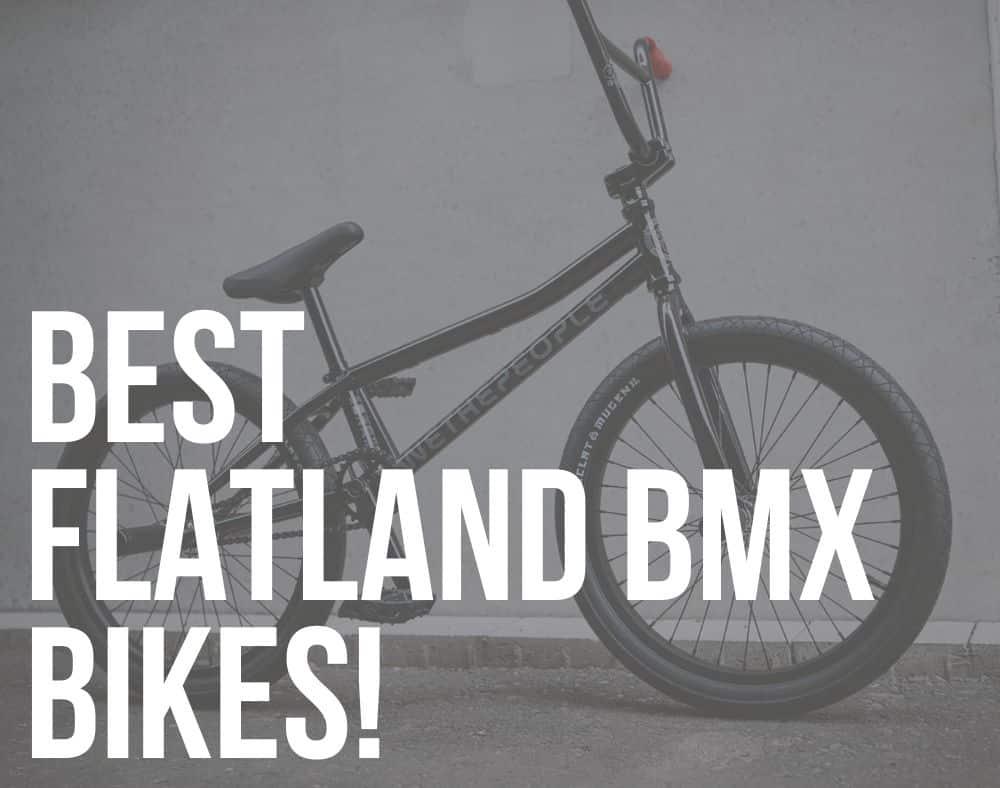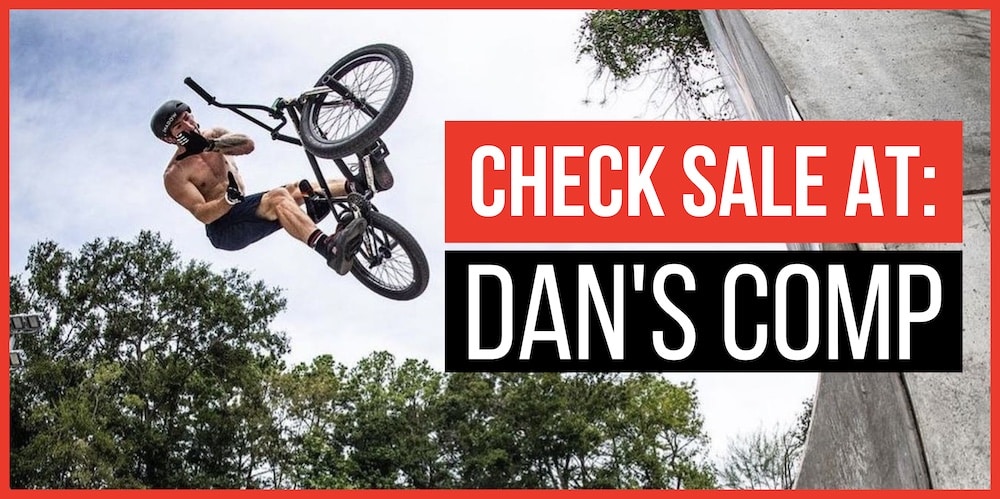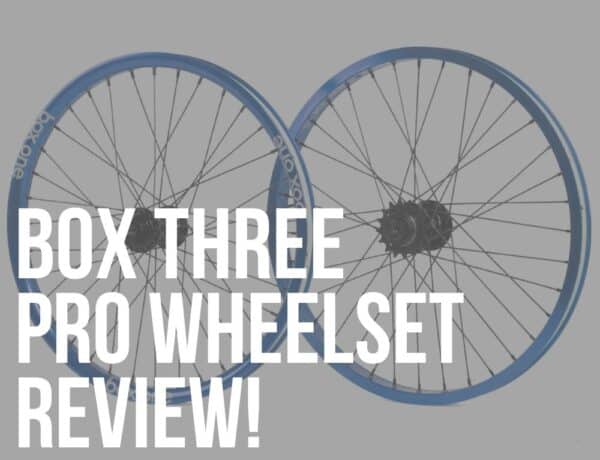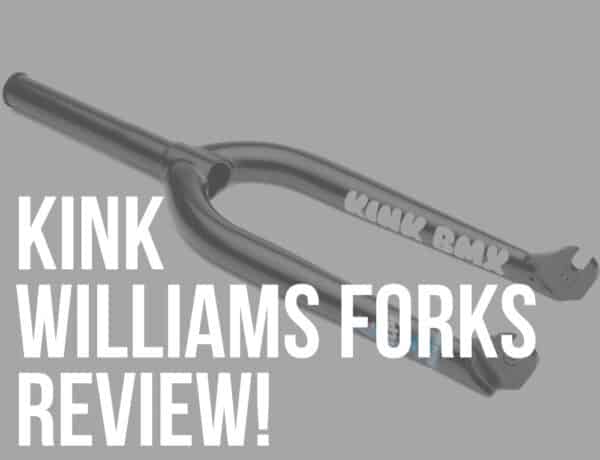Are you looking for the best BMX flatland bikes to help you make progress faster?
Flatland BMX is pure creativity on two wheels.
No ramps, no rails – just you, your bike, and an endless canvas of tricks.
It’s part art, part athleticism, and 100% addictive.
That’s why THE RIGHT BIKE makes all the difference, whether you’re linking your first steamroller combos or dialing in decades-long rolling tricks that turn heads at the spot.
I created this guide and comprehensive bike roundup for riders seeking a machine that feels like an extension of their body.
Responsive, balanced, and ready for whatever wild idea strikes you mid-session.
The bikes are purpose-built tools that handle the tight geometry, smooth rolling, and peg-friendly setups for demanding flatland needs.
From beginner-friendly completes to pro-level builds stacked with aftermarket parts, I’ve rounded up the bikes that stand out for their geometry, weight, and component choices.
Note: Sadly, there aren’t many complete flatland BMX bikes available.
So, whether you’re stepping into flatland for the first time or you’re already deep into the trick addiction, you’ll find a ride here that can keep up with your progression.
With the right setup under your feet, every parking lot, basketball court, and smooth patch of pavement becomes your stage.
This post covers:
- What Makes A Good BMX Flatland Bike?
- Complete Flatland Bikes Vs Custom Builds
- Best BMX Flatland Bikes
- Conclusion: Get The Right Flatland BMX Bike!
- FAQs About BMX Flatland Bikes
What Makes A Good BMX Flatland Bike?
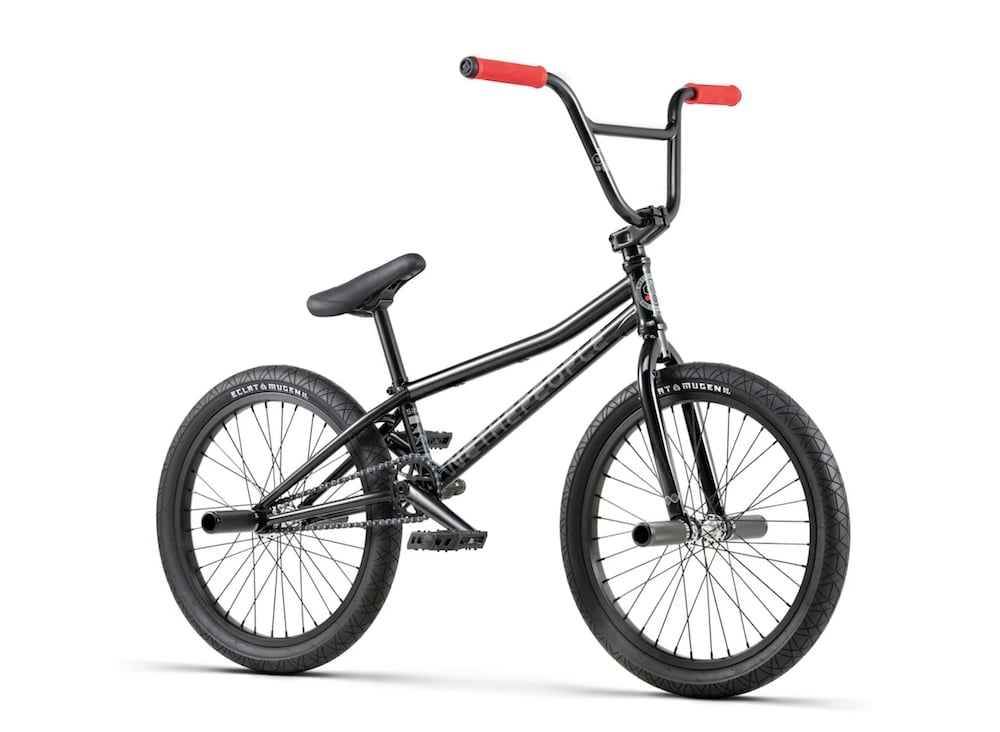
Flatland is a different beast compared to street, park or trail riding.
Every inch of your bike matters because the tricks you’re pulling off happen in such tight spaces and rely on TOTAL control.
You’re not just pedaling fast toward a rail – you’re balancing, scuffing, pivoting, and linking combos that can last minutes.
And the wrong bike geometry or components can feel like riding through mud, while the right setup makes it all feel flawless.
A good flatland BMX bike is quick to react, light enough to whip around, and balanced so perfectly that you forget where the bike ends and you begin.
I’m talking short top tubes for instant responsiveness, 0mm offset forks for rock-solid front wheel balance, and freecoaster hubs so you can roll backward like it’s second nature.
Throw in a clean gyro setup for barspins and whiplashes without cable tangles, pegs that grip without snagging, and tires that glide like butter, and you’ve got the recipe for flatland magic.
This is where precision meets creativity.
The bikes that stand out aren’t just strong – they’re fine-tuned for flow.
And once you feel that perfect balance under your feet, you’ll understand why geometry, weight, and component choice can make or break your riding.
Pro tip: Be open to making a few final adjustments to the bike to make it work for you exclusively. For instance, maybe riding the handlebars slightly forward will work better for you. Or you like riding rear wheel centered and not slammed.
These small adjustments can make a drastic change – so play with optimizing your flatland bike and enjoy that next-level riding.
Complete Flatland Bikes Vs Custom Builds
When it comes to getting your flatland setup, the big question is: do you buy a complete bike or build one from scratch?
Both paths can take you on an amazing ride, but they’re very different journeys.
1. Getting A Complete Flatland Bike
Complete bikes give you a ready-to-roll package out of the box.
The geometry, parts, and style are already matched up, so you can start riding the second you tighten the last bolt.
They’re perfect if you want a solid setup without the stress of sourcing each part, and modern completes are so dialed that you can find pro-level options straight out of the box.
I highly recommend getting a complete to all beginner flatland riders.
2. Building A Custom Flatland Bike
Custom builds are for the rider who knows exactly what they want.
Or for those who love the process of piecing together their dream machine.
You choose every single detail: the frame (check out the best BMX flatland frames), fork, hubs, tires, even the crank length.
The payoff?
A bike that fits your style and preferences like a glove.
But it takes more time, more money, and a lot more decision-making.
Pro tip: I usually stick to two BMX brands only – one for the frame (and larger parts) and one for the rest of the parts. I just don’t like mixing too many brands on my bike.
If you’re newer to flatland, a complete bike is often the smarter move.
You’ll get geometry and parts that work together perfectly, plus the chance to learn what you do and don’t like.
As you progress, you can swap out parts and slowly transform it into your ideal custom.
Note: All the complete bikes I’ve added are compatible with aftermarket parts, making them easily upgradeable.
In the end, it’s not about which route is “better.”
It’s about which one fits your riding, budget, and patience for the build process.
Best BMX Flatland Bikes
1. Colony Apprentice BMX Flat Bike (!)

If you’re stepping into flatland for the first time – or coming back after a break – the Colony Apprentice is a smooth way to get rolling.
It’s built with a full chromoly frame, so you know strength is there, but it’s paired with flatland-specific geometry to make spins, scuffs, and pivots feel easier right from the start.
While the head tube angle isn’t steep (75°), the frame has a short 18.9″ top tube length and a short 12.4″ chainstay length. All this makes the bike super responsive.
But wait, there’s more.
The 0mm fork offset helps with balance and control during nose tricks.
One of the best parts? It comes complete with a Colony Clone freecoaster hub and detangler out of the box.
That means you can roll backwards without pedaling and throw in barspins or whiplashes without cable tangles – no upgrades needed.
The bike even includes four pegs, so you’re ready to hit front and rear tricks on day one.
Moreover, the 153mm cranks are also a nice touch, giving your legs room to move without clipping pegs or crank arms getting in the way.
Overall, the Apprentice feels dialed for learning and progressing in flatland.
Whether you’re working on basics like hang fives or pushing into more technical links, it’s ready to roll with you.
Colony Apprentice Bike Specifications
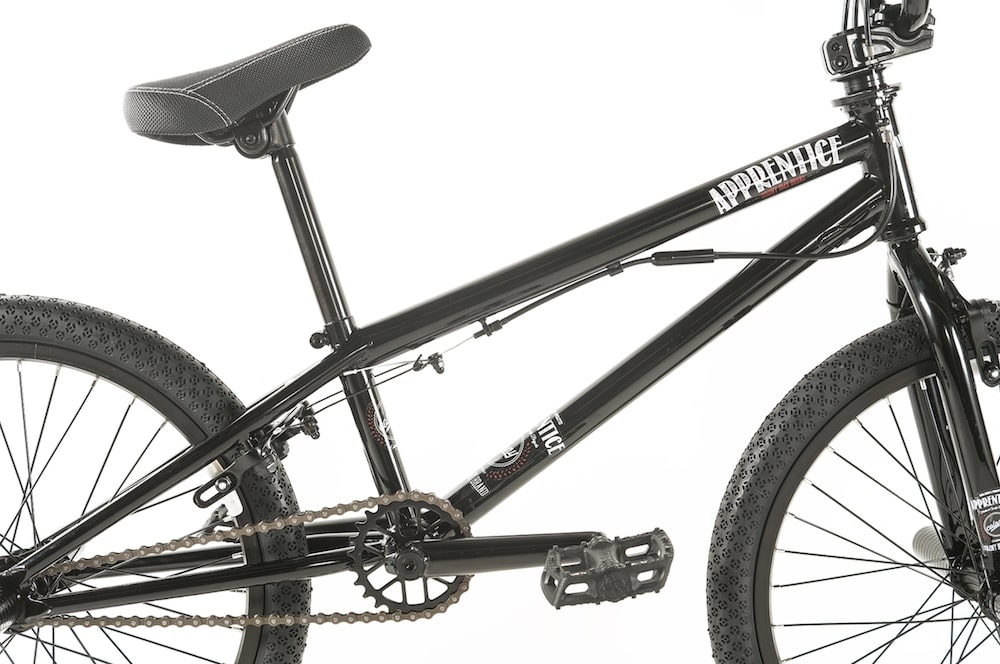
- Frame: Full chromoly (18.9″ TT)
- Fork: Hi-tensile steel w/ tapered legs & chromoly steerer tube (0mm offset)
- Headset: 1-1/8″ integrated
- Stem: Colony forged alloy topload (40mm reach)
- Bars: Colony chromoly 2-pc (8.9″ rise)
- Grips: Colony Much Room
- Cranks: Colony 153mm chromoly 3-pc w/ 8-spline spindle
- Bottom bracket: Sealed mid, 19mm
- Pedals: Colony Fantastic Plastic
- Sprocket: Colony Endeavour alloy (25T)
- Chain: KMC
- Front hub: Colony 3/8″ unsealed (36H)
- Rear hub: Colony Clone 14mm sealed freecoaster, 9T (36H)
- Rims: Alloy single-wall (20×1.75″)
- Tires: Colony EXON OEM 20×1.75″
- Seat: Colony railed seat with alloy seat post (330mm)
- Seat clamp: Integrated
- Brake lever: Alloy
- Brakes: Alloy U-brake w/ clear pads
- Gyro: Family Detangler Kit (Gyro Tabs Included)
- Brake mounts: Front & Rear
- Pegs: 4 Pegs
- Colors: Matte Black, Matte Apple Silver
- Weight: 26.5 lbs / 12.0 kg
- Price: $739.99
Colony Apprentice Frame Geometry
- Top tube length: 18.9″
- Chainstay length: 12.4″
- Head tube angle: 75°
- Seat tube angle: 72°
- Seat tube height: 6.9″
2. WeThePeople Sinus BMX Flat Bike (Full Chromoly)
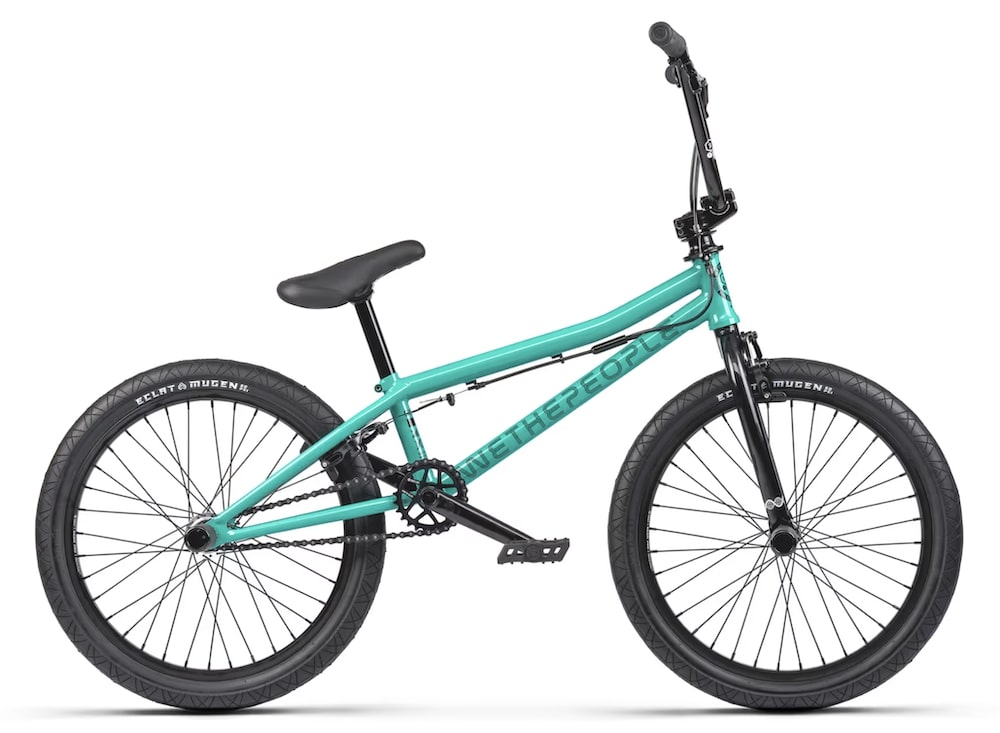
WeThePeople’s Sinus is a fresh, high-end complete designed to keep the flatland scene alive and thriving.
Built with Utopia-inspired geometry, this full chromoly machine is made for precision, smooth control, and lasting strength.
The 19″ top tube and 12.5″ chainstay hit that sweet spot for responsive balance, while the 0mm offset fork gives you stability for front wheel tricks.
Also, the standover height is pretty low (6.22″), so the frame is less likely to get in the way – giving you more freedom.
At 23.5 lbs, it’s noticeably lighter than the Colony Apprentice, making it easier to whip around during technical combos.
Out of the box, the Sinus is stacked with premium parts from WTP and Eclat: Mugen flatland tires for max grip, the Hybrid freecoaster hub (!) that can swap to cassette mode, and a full gyro setup with both front and rear brakes (removable mounts for a clean look if you ride brakeless).
Additionally, four alloy pegs come stock, so you’re ready for every front and rear peg trick imaginable.
If you’re just starting or you’ve been riding for years, the Sinus is a top-tier platform for pushing your limits in style.
WeThePeople Sinus Bike Specifications
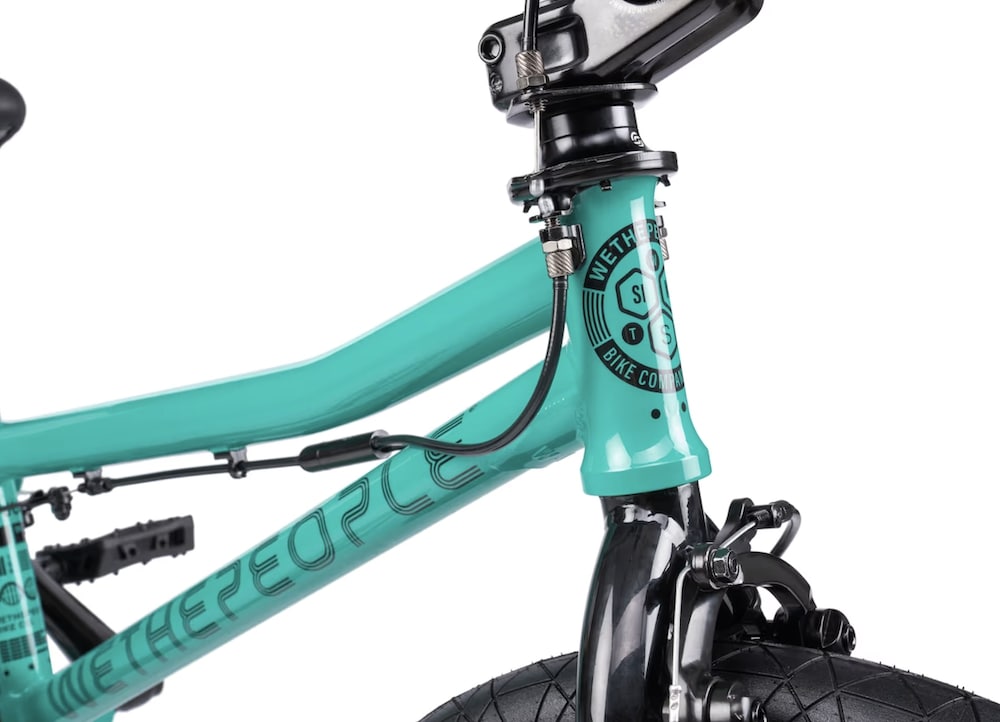
- Frame: WTP Sinus, 4130 full chromoly, tapered seatstays & chainstays (19″ TT)
- Fork: SaltPlus Sinus, 4130 full chromoly, removable brake pivots (0mm offset)
- Headset: Salt Pro, integrated, sealed
- Stem: Salt Junior topload (40mm reach)
- Bars: SaltPlus Sinus, 2-pc, 4130 chromoly, lowered crossbar (8.75″ rise, 28.25″ width, 5° backsweep, 3° upsweep)
- Grips: Salt EX, flangeless (154mm)
- Cranks: SaltPlus Ultra, 3-pc chromoly (8-spline, 165mm)
- Bottom bracket: Salt Spanish sealed (19mm)
- Pedals: Eclat Surge, nylon/fiberglass
- Sprocket: Eclat Exile, CNC 7075-T6 alloy (25T)
- Chain: Salt AM Z1 type
- Front hub: WTP Sinus, fully sealed (3/8″ axle)
- Rear hub: WTP Hybrid freecoaster, fully sealed, 9T (14mm axle, convertible to cassette)
- Rims: Salt Beam Pro, double-wall (36h)
- Tires: Eclat Mugen 20×1.9″
- Seat: WTP Sinus pivotal with Salt AM alloy pivotal seat post (200mm)
- Seat clamp: Integrated
- Brakes: Salt Rookie alloy U-brake (front & rear)
- Brake lever: Salt Rookie alloy (front & rear)
- Gyro: Included (Gyro Tabs Included)
- Brake mounts: Removable (front & rear)
- Pegs: WTP Sinus alloy (4.35″ x 37mm, set of 4)
- Colors: Black, Fresh Mint
- Weight: 23.5 lbs / 10.6 kg
- Price: $859.99
WTP Sinus Frame Geometry
- Top tube length: 19″
- Chainstay length: 12.5″
- Head tube angle: 75°
- Seat tube angle: 71°
- Bottom bracket height: 12.2″
- Standover: 6.22″
Conclusion: Get The Right Flatland BMX Bike!
If you’re serious about flatland, your bike is more than just a tool – it’s your partner in every trick, link, and creative line you dream up.
It’ll become your best BUDDY!
The right setup can make the difference between struggling to hold balance and effortlessly flowing through combos.
Every bike in this guide was chosen because it offers geometry, weight, and parts that help you progress faster and ride with more confidence.
Sure, you can get by on a cheaper or non-flatland-specific setup for a while, but if you’re committed to pushing your riding, it’s worth investing in something built for the job.
This is why the WeThePeople Sinus stands out.
It’s full chromoly, loaded with aftermarket parts, and fine-tuned for precision.
That means you get a bike that’s light, strong, and ready for years of progression without feeling outdated. (Plus, it’s easy to upgrade it with any aftermarket part you want.)
Don’t let the wrong bike slow you down or make sessions more frustrating than they need to be.
I’ve seen it too often.
What saddens me the most is that the wrong bike demotivated many riders to the point of quitting.
And I don’t want that to be you!
Choose a setup that works with you, not against you.
The moment you step on a proper flatland machine, you’ll feel it – more control, more flow, more fun.
Whether you pick the Sinus or Apprentice or another dialed complete, make the move now.
Your riding deserves it, and every future session will thank you.
FAQs About BMX Flatland Bikes
What’s the ideal TT length for BMX flatland frames?
Most flatland riders prefer shorter top tube lengths between 18.5” and 19.5” for maximum responsiveness. Shorter frames make it easier to spin and control the bike in tight spaces.
Can you use a street BMX for flatland riding?
Yes, but it’s not ideal. Street bikes usually have longer geometry and heavier setups, which can feel sluggish for flatland tricks. A dedicated flatland bike will feel more balanced and easier to control. But more and more flatlanders mix their riding with street, like Matthias Dandois.
Is brakeless better for BMX flatland?
It depends on your style. Many flatlanders run front and rear brakes for more trick variety (at least at the beginning/learning stage), while others prefer brakeless for a cleaner feel and lighter weight. Brakeless riding often requires EVEN MORE balance.
Do I need a freecoaster for flatland riding?
Yes, a freecoaster hub is highly recommended because it lets you roll backward without pedaling, opening up a wider range of tricks.
What’s the best crank length for BMX flatland?
Shorter cranks (150mm – 165mm) are preferred because they provide more clearance for your feet during tricks and reduce the chance of hitting pegs.
Are BMX flatland tires different from street tires?
Yes, flatland tires are usually narrower (around 1.75” – 1.95”) with smooth tread for minimal rolling resistance and better balance during pivots and spins.
Can you upgrade a complete BMX flatland bike over time?
Yes. Modern completes, especially high-quality ones like the WTP Sinus, come with standard parts you can swap out as your preferences evolve.

